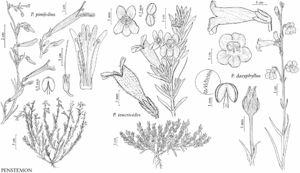Penstemon pinifolius
Bot. Gaz. 6: 218. 1881.
Stems erect, (5–)10–50 cm, glabrous or retrorsely hairy, hairs pointed. Leaves leathery, sparsely retrorsely hairy, hairs pointed, especially along margins, or glabrous; cauline 10–30 pairs, sessile, 4–32 × 0.5–1.2 mm, blade linear, base tapered to clasping, apex acuminate. Thyrses interrupted, secund, (1–)3–15 cm, axis retrorsely hairy to puberulent, or glabrous, verticillasters 1–7, cymes 1–3-flowered, 1(or 2) per node; proximal bracts linear, 3–14 × 0.3–1 mm; peduncles and pedicels ascending to erect, glandular-pubescent, sometimes puberulent. Flowers: calyx lobes lanceolate, 5–7 × 1.5–2 mm, scarious-margined, glandular-pubescent, hairs pointed; corolla scarlet, throat sometimes yellow or yellow- or orange-spotted, unlined internally, salverform, 25–32 mm, yellow-lanate internally abaxially, tube 4–6 mm, throat slightly inflated, 4–5 mm diam., slightly 2-ridged abaxially; stamens exserted (often hidden by galeate adaxial lobes), filaments glabrous, pollen sacs opposite, explanate, 0.8–1 mm, sutures smooth; staminode 12–17 mm, included, slightly flattened distally, 0.1–0.2 mm diam., tip straight, distal 9–10 mm densely pilose, hairs yellow, to 1.3 mm; style 21–27 mm. Capsules 5–9 × 3–4 mm. 2n = 16.
Phenology: Flowering Jun–Jul(–Sep).
Habitat: Rocky slopes, cliffs.
Elevation: 1800–3100 m.
Distribution
Ariz., N.Mex., Mexico (Chihuahua, Sonora).
Discussion
Penstemon pinifolius has been included as an anomalous member of sect. Leptostemon Trautvetter; R. M. Straw (1962) expressed doubt about that association. It was allied with members of sect. Caespitosi in the molecular study by A. D. Wolfe et al. (2006).
Selected References
None.
